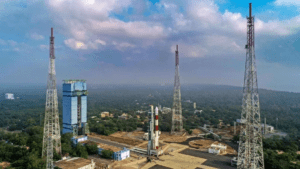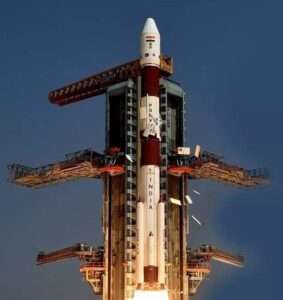“The initiation of the XPoSAT mission also signified the 60th voyage of the Polar Satellite Launch Vehicle (PSLV)”.

Embarking on the extraordinary journey of the XPoSat Mission Launch, ISRO not only set its sights on the celestial frontier but also celebrated the monumental 60th flight of the Polar Satellite Launch Vehicle (PSLV). This cosmic odyssey signifies a fusion of cutting-edge technology and the rich legacy of space exploration, encapsulating the essence of innovation that propels us into the cosmic unknown. Join us as we delve into the cosmic tapestry, where each launch becomes a testament to human ingenuity and the relentless pursuit of unlocking the mysteries that lie beyond our earthly confines.
India’s space agency, the Indian Space Research Organisation (ISRO), has successfully launched the XPoSat mission, making it the second country after the United States to embark on a dedicated mission to study black holes and neutron stars. This ambitious mission marks a significant milestone for India’s space program and its scientific community.
- Inaugural Odyssey: The XPoSat Mission Launch marks a pioneering voyage into the uncharted realms of space exploration, pushing the boundaries of human achievement.
- Milestone Celebration: ISRO’s grand venture is not just another space mission; it commemorates the remarkable 60th flight of the Polar Satellite Launch Vehicle (PSLV), a testament to India’s prowess in aerospace technology.
- Celestial Fusion: The mission seamlessly intertwines state-of-the-art technology with the legacy of space exploration, creating a celestial symphony that resonates with innovation.
- Cosmic Frontier: XPoSat boldly ventures into the cosmic frontier, unlocking mysteries and expanding our understanding of the vast, enigmatic universe that surrounds us.
- Technological Marvel: Witness the convergence of cutting-edge technology as XPoSat propels itself into the cosmos, showcasing the pinnacle of scientific and engineering prowess.
- Legacy of Innovation: ISRO’s journey is a narrative of continuous innovation, pushing the boundaries of what we thought possible and inspiring future generations to reach for the stars.
- Cosmic Tapestry: Each launch is a brushstroke on the cosmic tapestry, weaving together the stories of human ingenuity and determination to explore the infinite expanses beyond our home planet.
- Exploration Unleashed: The XPoSat Mission Launch isn’t just a mission; it’s an unleashed exploration, a daring quest to uncover the secrets hidden within the cosmic fabric.
- Beyond Earthly Confines: Join the cosmic odyssey as XPoSat propels humanity beyond the earthly confines, offering a glimpse into the vastness that lies beyond our familiar blue planet.
- Relentless Pursuit: Every launch is a manifestation of the relentless pursuit to unravel the mysteries of the universe, pushing the boundaries of our knowledge and redefining our place in the cosmos.


XPoSat: Unveiling the Cosmic Tapestry
The XPoSat mission carries with it the ambitious vision of unraveling the secrets cloaked within black holes and neutron stars, the most captivating and perplexing celestial objects in the universe. Equipped with cutting-edge instruments like high-resolution X-ray cameras and spectrometers, XPoSat will meticulously observe these celestial powerhouses, deciphering the language of their X-ray emissions and their intricate interactions with surrounding matter.
Surpassing Boundaries, Expanding Knowledge
XPoSat’s scientific prowess transcends geographical borders, promising to unlock a treasure trove of knowledge for the global scientific community. By meticulously studying the dance of light and gravity around black holes and neutron stars, scientists hope to gain profound insights into the fundamental laws of physics that govern our universe. This mission has the potential to revolutionize our understanding of stellar evolution, the formation of galaxies, and the very fabric of spacetime itself.


A Testament to India’s Audacious Spirit
The success of the XPoSat mission stands as a beacon of India’s audacious spirit in the realm of space exploration. It not only underscores the nation’s technological prowess but also fuels the aspirations of future generations to embark on cosmic voyages of discovery. XPoSat’s journey serves as a testament to the unwavering dedication of ISRO’s scientists and engineers, who have consistently pushed the boundaries of human knowledge and innovation.
A New Chapter in the Cosmic Saga
The launch of XPoSat marks the dawn of a new chapter in the ongoing saga of cosmic exploration. As this intrepid spacecraft ventures into the uncharted territories surrounding black holes and neutron stars, it carries with it the hopes and aspirations of millions. XPoSat’s discoveries promise to rewrite textbooks, redefine our understanding of the universe, and inspire generations to come to reach for the stars.
XPoSat’s Scientific Goals:
- Unraveling the Mysteries of Black Holes and Neutron Stars: The primary objective of the XPoSat mission is to study the extreme environments surrounding black holes and neutron stars, which are some of the most fascinating and enigmatic objects in the universe. XPoSat will carry out detailed observations of these celestial bodies, focusing on their X-ray emissions and their interactions with surrounding matter.
- Unlocking the Secrets of the Universe: By studying black holes and neutron stars, scientists hope to gain a deeper understanding of gravity, matter, and the fundamental laws of physics. These observations could also shed light on the formation and evolution of galaxies and the universe as a whole.


Technical Prowess of the Mission:
- XPoSat: A Cutting-Edge Satellite: The XPoSat satellite is equipped with state-of-the-art instruments specifically designed to study black holes and neutron stars. These instruments include high-resolution X-ray cameras and spectrometers that will allow scientists to collect precise data on these celestial objects.
- PSLV: A Reliable Launch Vehicle: The XPoSat satellite was launched into space aboard the Polar Satellite Launch Vehicle (PSLV), a proven and reliable launch vehicle developed by ISRO. The successful launch of XPoSat further cements India’s position as a leading spacefaring nation.


Significance for India’s Space Program:
- Boosting Scientific Research: The XPoSat mission will provide valuable data for Indian scientists studying black holes and neutron stars. This will contribute to the advancement of astrophysics research in India and place the country at the forefront of this exciting field.
- Inspiring Future Generations: The success of the XPoSat mission will inspire young people in India to pursue careers in science and technology. It will also demonstrate India’s commitment to space exploration.


Here are 10 facts from this big stories at a glance :
- At 9:32 am, ISRO declared that the takeoff of the Polar Satellite Launch Vehicle (PSLV) proceeded as planned, and XPoSAT was effectively deployed. ISRO shared, “PSLV-C58 vehicle accurately positioned the satellite into the designated orbit of 650 km with a 6-degree inclination. The scripting of POEM-3 is currently in progress,” in X. Shortly after, ISRO’s chief, S Somanath, confirmed the prosperous launch. Here, POEM refers to the PSLV Orbital Experimental Module.
- Astrophysicist Dipankar Bhattacharya stated that today’s launch was a “textbook launch.” He remarked, “The anticipated orbit has been attained. Now, all the anticipated scientific operations are expected to function as intended.”
- The launch of the XPoSAT mission also denoted the 60th expedition of the Polar Satellite Launch Vehicle (PSLV). The 260-ton rocket transports a sophisticated astronomy observatory designed for the examination of black holes and neutron stars. Consequently, India is poised to be the second nation, following the US(NASA), to possess an ‘observatory’ dedicated to the study of black holes.
- Employing X-ray photons and their polarization, XPoSAT aims to facilitate the examination of radiation emanating from the vicinity of black holes and neutron stars. The mission is equipped with two payloads — POLIX (Polarimeter Instrument in X-rays) and XSPECT (X-ray Spectroscopy and Timing).
- The satellite is designed to gauge the polarization of X-rays in the energy range of 8-30 keV originating from approximately 50 potential cosmic sources. This will be achieved through Thomson Scattering, facilitated by the POLIX payload.
- The satellite is set to conduct prolonged spectral and temporal investigations of cosmic X-ray sources. Additionally, it will perform polarimetric and spectroscopic assessments of X-ray emissions from cosmic sources, utilizing the POLIX and XSPECT payloads.
- As stars deplete their fuel and undergo the process of ‘dying,’ they implode due to their gravitational forces, leaving behind either black holes or neutron stars. Black holes possess the most powerful gravitational force in the universe, while neutron stars boast the highest densities. By delving deeper into these phenomena, the mission aims to unravel the mysteries surrounding ultra-extreme environments in space.
- The XPoSat satellite incurred a cost of approximately ₹250 crore (around $30 million). In comparison, NASA’s IXPE, undertaking a similar mission since 2021, had a budget of $188 million. The Indian satellite is anticipated to operate for over five years, surpassing the two-year lifespan of NASA’s IXPE.
- G Madhavan Nair, former chairman of ISRO, asserted that the PSLV rocket system has developed into the most dependable and cost-efficient option on the global stage. Reflecting on the historical trajectory, he stated, “Our journey began in 1993, and since then, a majority of the missions have been executed successfully.”.
- The year 2023 proved to be significant for both ISRO and the nation. The triumph of the Chandrayaan mission elevated India into the exclusive space community, securing the unique feat of executing a soft landing near the South Pole of the moon. As 2024 commences, ISRO is directing its attention towards the Gaganyaan launch, which marks India’s inaugural human spaceflight program.
